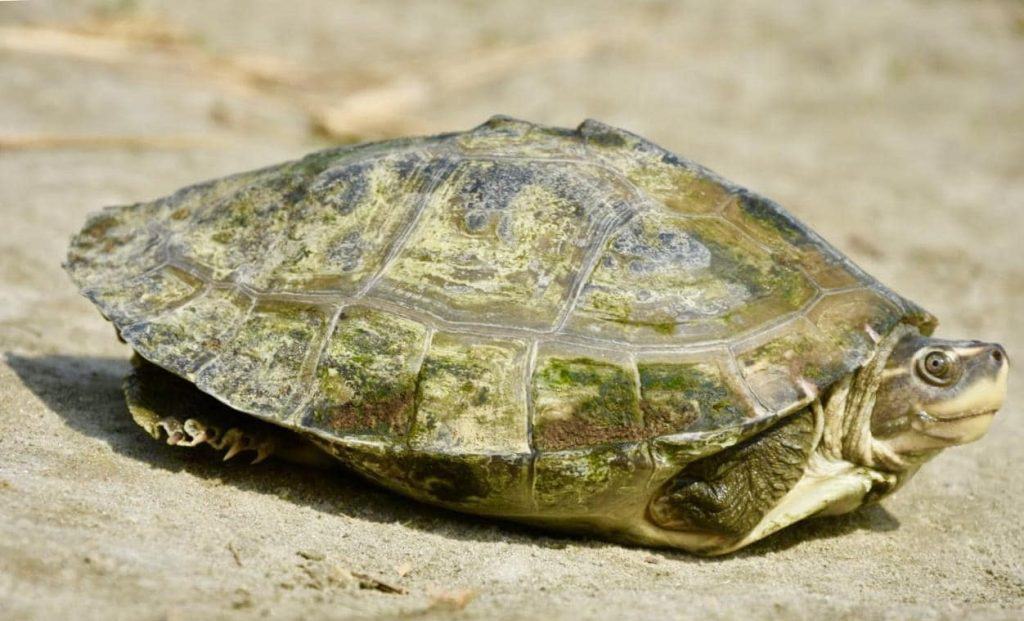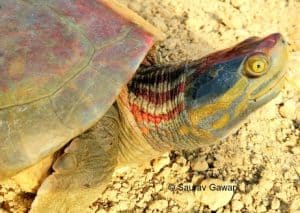Batagur dhongoka (Three-striped Roofed Turtle)
Home > Turtle Database > Batagur dhongoka (Three-striped Roofed Turtle)

The Batagur dhongoka, commonly known as the Three-striped Roofed Turtle, is a distinctive species of river turtle primarily found in the river systems of South Asia. It is recognized for its unique shell pattern and conservation significance due to its declining population.
Native To These Regions
Assam (India), Bangladesh, Bihar (India), Madhya Pradesh (India), Odisha (India), Uttar Pradesh (India), West Bengal (India)Native Turtle Species Map – Find Turtles by Region
Scientific Classification
- Kingdom: Animalia
- Phylum: Chordata
- Class: Reptilia
- Order: Testudines
- Family: Geoemydidae
- Genus: Batagur
- Species: B. dhongoka
Common Names
- Three-striped Roofed Turtle
- Northern River Terrapin
This Hilarious Turtle Book Might Know Your Pet Better Than You Do
Let’s be real—most turtle care guides feel like reading a textbook written by a sleep-deprived zookeeper.
This one’s not that.
Told from the snarky point of view of a grumpy, judgmental turtle, 21 Turtle Truths You’ll Never Read in a Care Guide is packed with sarcasm, sass, and surprisingly useful insights.
And hey—you don’t have to commit to the whole thing just yet.
Grab 2 free truths from the ebook and get a taste of what your turtle really thinks about your setup, your food choices, and that weird plastic palm tree.
It’s funny, it’s honest, and if you’ve ever owned a turtle who glares at you like you’re the problem—you’ll feel seen.
Identification
- Description: This turtle features a carapace that is moderately domed with three distinct longitudinal keels that are more pronounced in juveniles. The coloration is generally brown with clearer patterns in younger individuals.
- Sexual Dimorphism: Males are generally smaller and have a narrower and longer tail compared to females. They also display brighter colors during the breeding season.
Check more turtles from the Batagur genus
Native Origin and Distribution
- Geographical Range: Batagur dhongoka is native to the northern river systems of India, extending to Bangladesh and Nepal.
Preferred Habitat
This species prefers large, flowing rivers with sandy or muddy banks where it can bask and nest.
Behavior
- Feeding Habits: It is omnivorous, feeding on aquatic vegetation, fruits, and occasionally on fish and carrion.
- Predators: Natural predators include large fish, birds, and mammals that prey on eggs and juveniles.
Reproduction
- Breeding Season: The breeding season occurs shortly before the onset of the monsoon season.
- Reproductive Method: Females lay eggs in nests dug on sandy riverbanks. The eggs are incubated by the heat of the sun and hatch after about 60-90 days.
Conservation
- Extinction Status: Listed as Vulnerable by the IUCN Red List.
- Threats: Major threats include habitat destruction, pollution, and poaching for the pet trade and traditional medicine.
- Conservation Measures: Efforts include habitat protection, anti-poaching patrols, and breeding programs in captivity.
Economic Importance
The species is of ecological significance, helping maintain riverine ecosystems. However, it faces threats from illegal trade for its meat and shells.
Interesting Facts
- Batagur dhongoka can alter its body temperature by changing its location in the water column, a behavior known as behavioral thermoregulation.
- They are known to travel long distances during the breeding season, which can span several hundred kilometers.
Research Studies
Here is a link to a research paper on Batagur dhongoka: Conservation Genetics of Batagur dhongoka. This study provides insights into the genetic diversity and structure of the population, which are crucial for framing effective conservation strategies.

About Author
Muntaseer Rahman started keeping pet turtles back in 2013. He also owns the largest Turtle & Tortoise Facebook community in Bangladesh. These days he is mostly active on Facebook.














